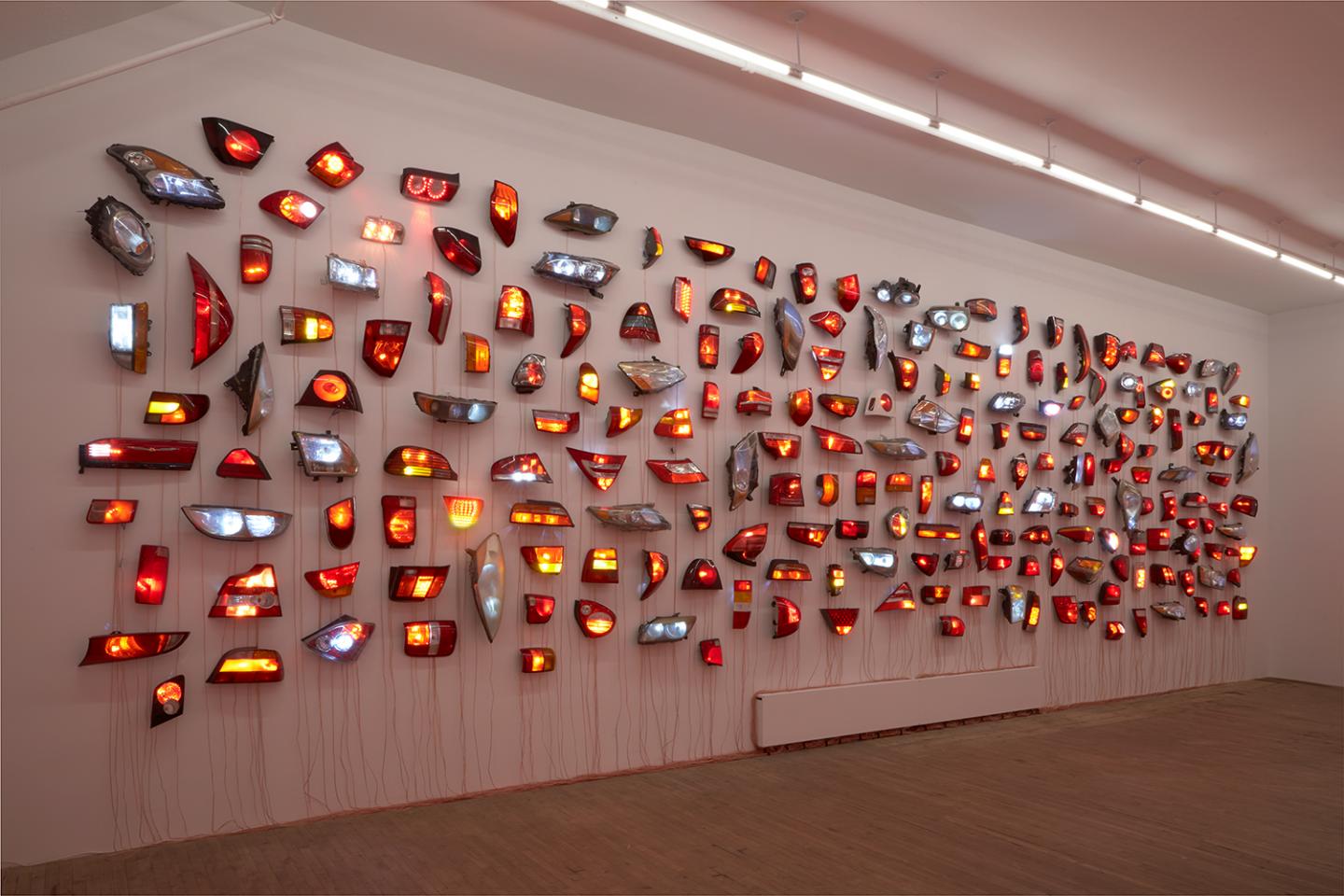A Little Light Music
Madeline Hollander’s BMW Open Work commission utilizes recycled headlights to explore forms of human connectivity
Madeline Hollander’s BMW Open Work commission utilizes recycled headlights to explore forms of human connectivity

There comes a point when the act of driving feels less active than passive. Instinctive, almost unthought. Writing of the Los Angeles road network in The White Album (1979), Joan Didion termed this condition ‘actual participation’, ‘a concentration so intense’ it becomes ‘a rapture-of-the-freeway’ At this moment, you are neither leading nor being led, but occupying a warm space in between, synchronized with the manoeuvres of moving through space. In Didion’s words: ‘The mind goes clean. The rhythm takes over.’ Mirror, signal, merge.
Madeline Hollander mines such instants of actual participation, in which technologies and bodies harmonize to create something more, something other than they were before. As a choreographer, dancer and artist, Hollander positions the systems and devices of industrial modernity alongside sequences of human motion and behaviour in order to visualize the ways in which society and its urban environment have informed one another over time. For Arena (2017), she devised a performative duet between a group of dancers and a beach raking truck, while Drill (2016) saw performers circumnavigating a succession of emergency evacuation routes devised for museums, aeroplanes and cinemas. For New Max (2018), the bodies of Hollander’s dancers created temperature fluctuations at The Artist’s Institute, New York, which triggered corrective responses from in situ air-conditioning units: a productive partnership between animate and inanimate that visualized the erratic heat patterns occasioned by the climate crisis. In conversation, Hollander says: ‘I’ve never really thought of a separation between the human and the technological.’
Hollander’s commission as part of BMW Open Work draws upon ‘Heads/Tails’, her 2020 exhibition at Bortolami in New York, which saw hundreds of wall-mounted headlights and taillights synchronized with traffic signals at the nearby intersection of Walker Street and Broadway. As the signals flashed red and the traffic slowed, so, too, did the taillights illuminate the gallery: glowing red gems, burning embers in a gust. While the responsive flickering of Hollander’s choreographed readymades may have appeared arbitrary, it was, in fact, devised using the New York City Department of Transportation’s algorithm for managing road traffic, which takes into consideration bus routes, pedestrians, weather data and live collision reports. Beneath the lights and logic is the delicate interplay of human agency and technology that, while unseen, oversees the safe passage of bodies through New York’s orthogonal grids.

Sunrise/Sunset, which will premiere at Frieze Los Angeles in February 2021, extends this research into headlights and the infrastructural operating systems that encompass both organic and technological agents. Capitalizing on the opportunity for dialogue with BMW’s experts, Hollander has collaborated with the company's engineers to develop twin mosaics of LED headlights, which will be subdivided into 12 columns, affixed to opposing walls to represent the earth’s eastern and western hemispheres. Powered by a Prismatic Li-Ion battery and programmed to react in real time to the progression of the sun, these headlights will intermittently transition through their intuitive adaptive settings – lifting into darkness, falling with the light – to create a luminous wave that mimics both the roving curve of the night and society’s attempt to navigate its shadow. Hollander has sourced all of these headlights from the BMW Group Recycling and Dismantling Centre, an act of creative sustainability that extends the work’s interest in planetary cycles and humanity’s vexed doubles. In October 2020, as part of the Frieze Viewing Room, Hollander’s solar cycle will be launched digitally as an interactive globe of 3D-rendered headlights, which will gently pirouette to mimic the prograde rotation of the Earth. Together, these two iterations of Sunrise/Sunset will comprise a radiant, durational diorama of the ongoingness of time and our collective experience of it: the experience, that is, of disparate individuals who are separate, but not really.
As with ‘Heads/Tails’ and New Max, Hollander’s intention with Sunrise/Sunset is to communicate our active participation in the infrastructural networks and autopoietic systems that, while often familiarized to the point of invisibility, are imperative to our collective continuation. In other hands, this might read as a cautionary tale: an admonishment of modernity’s ambition to codify human behaviour. But this work offers instead a hopeful investment in connectivity in all its forms. ‘If you touch an antenna,’ says Hollander, ‘you become an antenna, and the reception gets better’. ‘The body is electric,’ Hollander concludes, evoking the famous poem ‘I Sing the Body Electric’ from Walt Whitman’s 1855 Leaves of Grass. In the poem, Whitman writes: ‘The armies of those I love engirth me and I engirth them […] and charge them full with the charge of the soul.’ Separate but not really, together yet alone, each of us completing the circuit.
To view the first part of Madeline Hollander’s BMW Open Work commission online, register here for the Frieze Viewing Room. The second part of the commission will debut at Frieze Los Angeles 2021. Go here to read more about BMW Open Work.
Main image: Madeline Hollander, ‘Heads/Tails’, 2020, exhibition view, Bortolami, New York. Courtesy: the artist and Bortolami, New York
























